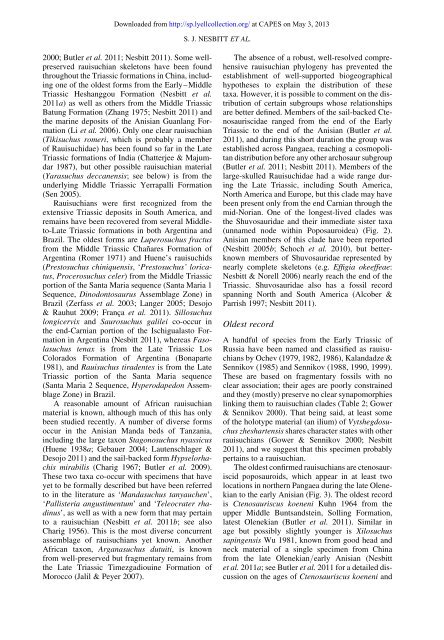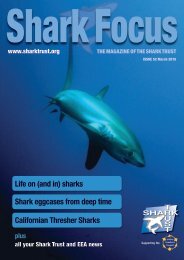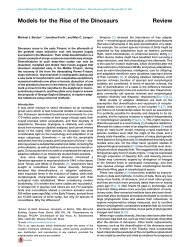(044) Nesbitt et al 2013
(044) Nesbitt et al 2013
(044) Nesbitt et al 2013
You also want an ePaper? Increase the reach of your titles
YUMPU automatically turns print PDFs into web optimized ePapers that Google loves.
Downloaded from http://sp.lyellcollection.org/ at CAPES on May 3, <strong>2013</strong>S. J. NESBITT ET AL.2000; Butler <strong>et</strong> <strong>al</strong>. 2011; <strong>Nesbitt</strong> 2011). Some wellpreservedrauisuchian skel<strong>et</strong>ons have been foundthroughout the Triassic formations in China, includingone of the oldest forms from the Early–MiddleTriassic Heshanggou Formation (<strong>Nesbitt</strong> <strong>et</strong> <strong>al</strong>.2011a) as well as others from the Middle TriassicBatung Formation (Zhang 1975; <strong>Nesbitt</strong> 2011) andthe marine deposits of the Anisian Guanlang Formation(Li <strong>et</strong> <strong>al</strong>. 2006). Only one clear rauisuchian(Tikisuchus romeri, which is probably a memberof Rauisuchidae) has been found so far in the LateTriassic formations of India (Chatterjee & Majumdar1987), but other possible rauisuchian materi<strong>al</strong>(Yarasuchus deccanensis; see below) is from theunderlying Middle Triassic Yerrap<strong>al</strong>li Formation(Sen 2005).Rauisuchians were first recognized from theextensive Triassic deposits in South America, andremains have been recovered from sever<strong>al</strong> Middl<strong>et</strong>o-LateTriassic formations in both Argentina andBrazil. The oldest forms are Luperosuchus fractusfrom the Middle Triassic Chañares Formation ofArgentina (Romer 1971) and Huene’s rauisuchids(Prestosuchus chiniquensis, ‘Prestosuchus’ loricatus,Procerosuchus celer) from the Middle Triassicportion of the Santa Maria sequence (Santa Maria 1Sequence, Dinodontosaurus Assemblage Zone) inBrazil (Zerfass <strong>et</strong> <strong>al</strong>. 2003; Langer 2005; Desojo& Rauhut 2009; França <strong>et</strong> <strong>al</strong>. 2011). Sillosuchuslongicervix and Saurosuchus g<strong>al</strong>ilei co-occur inthe end-Carnian portion of the Ischigu<strong>al</strong>asto Formationin Argentina (<strong>Nesbitt</strong> 2011), whereas Fasolasuchustenax is from the Late Triassic LosColorados Formation of Argentina (Bonaparte1981), and Rauisuchus tiradentes is from the LateTriassic portion of the Santa Maria sequence(Santa Maria 2 Sequence, Hyperodapedon AssemblageZone) in Brazil.A reasonable amount of African rauisuchianmateri<strong>al</strong> is known, <strong>al</strong>though much of this has onlybeen studied recently. A number of diverse formsoccur in the Anisian Manda beds of Tanzania,including the large taxon Stagonosuchus nyassicus(Huene 1938a; Gebauer 2004; Lautenschlager &Desojo 2011) and the sail-backed form Hypselorhachismirabilis (Charig 1967; Butler <strong>et</strong> <strong>al</strong>. 2009).These two taxa co-occur with specimens that havey<strong>et</strong> to be form<strong>al</strong>ly described but have been referredto in the literature as ‘Mandasuchus tanyauchen’,‘P<strong>al</strong>listeria angustimentum’ and ‘Teleocrater rhadinus’,as well as with a new form that may pertainto a rauisuchian (<strong>Nesbitt</strong> <strong>et</strong> <strong>al</strong>. 2011b; see <strong>al</strong>soCharig 1956). This is the most diverse concurrentassemblage of rauisuchians y<strong>et</strong> known. AnotherAfrican taxon, Arganasuchus dutuiti, is knownfrom well-preserved but fragmentary remains fromthe Late Triassic Timezgadiouine Formation ofMorocco (J<strong>al</strong>il & Peyer 2007).The absence of a robust, well-resolved comprehensiverauisuchian phylogeny has prevented theestablishment of well-supported biogeographic<strong>al</strong>hypotheses to explain the distribution of thes<strong>et</strong>axa. However, it is possible to comment on the distributionof certain subgroups whose relationshipsare b<strong>et</strong>ter defined. Members of the sail-backed Ctenosauriscidaeranged from the end of the EarlyTriassic to the end of the Anisian (Butler <strong>et</strong> <strong>al</strong>.2011), and during this short duration the group wasestablished across Pangaea, reaching a cosmopolitandistribution before any other archosaur subgroup(Butler <strong>et</strong> <strong>al</strong>. 2011; <strong>Nesbitt</strong> 2011). Members of thelarge-skulled Rauisuchidae had a wide range duringthe Late Triassic, including South America,North America and Europe, but this clade may havebeen present only from the end Carnian through themid-Norian. One of the longest-lived clades wasthe Shuvosauridae and their immediate sister taxa(unnamed node within Poposauroidea) (Fig. 2).Anisian members of this clade have been reported(<strong>Nesbitt</strong> 2005b; Schoch <strong>et</strong> <strong>al</strong>. 2010), but b<strong>et</strong>terknownmembers of Shuvosauridae represented bynearly compl<strong>et</strong>e skel<strong>et</strong>ons (e.g. Effigia okeeffeae:<strong>Nesbitt</strong> & Norell 2006) nearly reach the end of theTriassic. Shuvosauridae <strong>al</strong>so has a fossil recordspanning North and South America (Alcober &Parrish 1997; <strong>Nesbitt</strong> 2011).Oldest recordA handful of species from the Early Triassic ofRussia have been named and classified as rauisuchiansby Ochev (1979, 1982, 1986), K<strong>al</strong>andadze &Sennikov (1985) and Sennikov (1988, 1990, 1999).These are based on fragmentary fossils with noclear association; their ages are poorly constrainedand they (mostly) preserve no clear synapomorphieslinking them to rauisuchian clades (Table 2; Gower& Sennikov 2000). That being said, at least someof the holotype materi<strong>al</strong> (an ilium) of Vytshegdosuchuszheshartensis shares character states with otherrauisuchians (Gower & Sennikov 2000; <strong>Nesbitt</strong>2011), and we suggest that this specimen probablypertains to a rauisuchian.The oldest confirmed rauisuchians are ctenosauriscidpoposauroids, which appear in at least twolocations in northern Pangaea during the late Olenekianto the early Anisian (Fig. 3). The oldest recordis Ctenosauriscus koeneni Kuhn 1964 from theupper Middle Buntsandstein, Solling Formation,latest Olenekian (Butler <strong>et</strong> <strong>al</strong>. 2011). Similar inage but possibly slightly younger is Xilosuchussapingensis Wu 1981, known from good head andneck materi<strong>al</strong> of a single specimen from Chinafrom the late Olenekian/early Anisian (<strong>Nesbitt</strong><strong>et</strong> <strong>al</strong>. 2011a; see Butler <strong>et</strong> <strong>al</strong>. 2011 for a d<strong>et</strong>ailed discussionon the ages of Ctenosauriscus koeneni and




